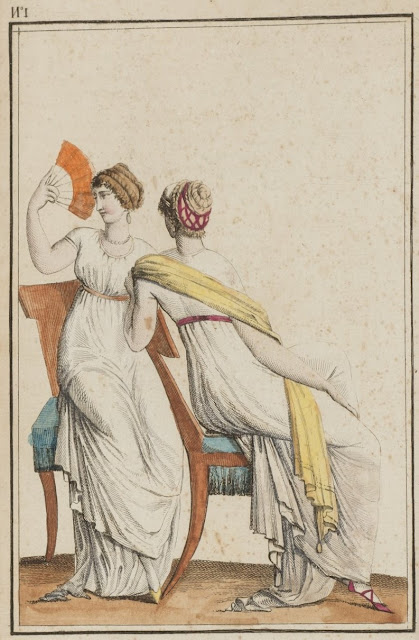Tableau Général de Goût, no. 1 pl. 1
 |
| 1 Vendemier, an 7 (22 Sept. 1798) |
TWO WOMEN DRESSED A LA ROMAINE.
No. 1 Hair braided and arranged in a spiral, enclosed in a net of red wool.
This coiffure imitates the antique, and goes with their dress. It is not rare, though it is ridiculous, to see undress caps, velvet hats, cornettes of linen gauze, satin bonnets trimmed with plumes, toques of bouillonnée gauze, turbans topped with a feather - one or another of these modern headdresses decorating the head of a woman in a tunic, in cothurnes,* and draped à la romaine. This discrepancy shocks good taste, but to each her own, and the proverb is right.
White tunic. This dress requires a good figure and a trim waist: these tunics are sleeveless, but often the rigors of the weather or a purer motive accessorizes them with very tight sleeves of knitted silk. The fashion of these sleeves has, however, fallen into disuse; since it has become trivial, nudity is preferred.
Shawl. The tassel attached to the tip of the shawl gives it the character of a Roman costume. These shawls are neither very new nor very common.
Shoes of red morocco, with cothurnes. The fashion of cothurnes still continues, however the shoe tied with a cord ending in two little tassels of gold or silver silk is fighting for preference.
No. 2. Hair tied up à la grecque. Tunic without sleeves; yellow shoes.
Fan. The shape of fans never changes; their size alone is subject to the caprices of fashion. Fans are usually very little. The newest are enameled, mounted on crepe or black taffeta; their richness comes from the amount of gold sequins which vary the design.
* Neoclassical shoes. The cothurnus was worn to perform Athenian tragedies and was apparently a thick-soled boot - in this period, I think it refers to something more like a half-boot.



Comments
Post a Comment